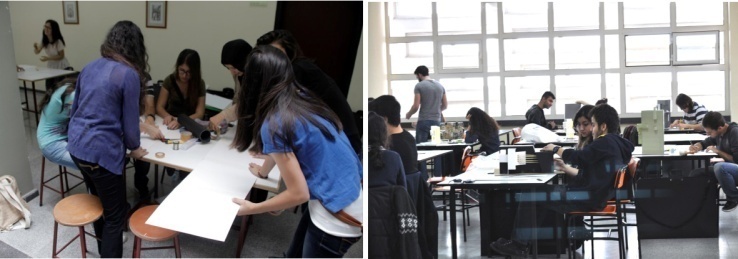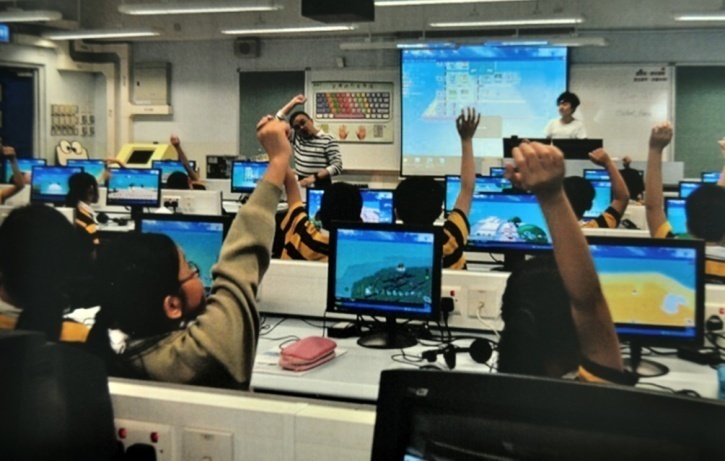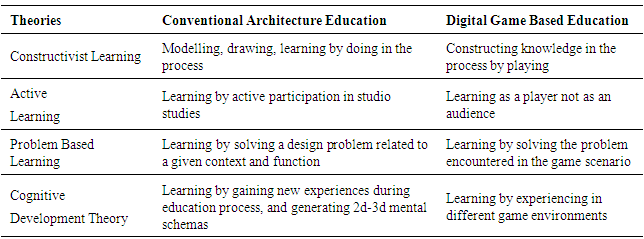-
Paper Information
- Paper Submission
-
Journal Information
- About This Journal
- Editorial Board
- Current Issue
- Archive
- Author Guidelines
- Contact Us
Architecture Research
p-ISSN: 2168-507X e-ISSN: 2168-5088
2016; 6(3): 51-56
doi:10.5923/j.arch.20160603.01

Theoretical Framework for Using Digital Games in Architecture Education
Burcu Gülay Taşçı
Assistant Professor Doctor, İzmir Dokuz Eylül University, Department of Architecture Tınaztepe Campus, Buca İzmir, Turkey
Correspondence to: Burcu Gülay Taşçı, Assistant Professor Doctor, İzmir Dokuz Eylül University, Department of Architecture Tınaztepe Campus, Buca İzmir, Turkey.
| Email: |  |
Copyright © 2016 Scientific & Academic Publishing. All Rights Reserved.
This work is licensed under the Creative Commons Attribution International License (CC BY).
http://creativecommons.org/licenses/by/4.0/

In today's digital age, it is recognized that children, who are born in a world of technological resources, cannot be educated via conventional methods. As in many other fields, rapidly advancing technology caused certain revisions in the field of education. In today's architecture education, the utilization of digital games is one example of the mentioned revisions. However as the studies conducted up to date are taken into consideration, it is seen that the literature lacks studies investigating theoretic relation between the architecture education and learning via digital games. The subject of this study is the core of conventional architecture education, the place of the learning via digital games and the integration of digital games to architecture education via theoretical infrastructure. The aim of the article prepared originated from the lack of studies in the literature is to reveal the relation between the learning via digital games and architecture education in general. For the study conducted with this aim, the screening model is utilized and data is collected via reviewing the literature. The findings obtained throughout literature have revealed the theoretical common ground between the conventional architecture education and learning via digital gaming approach. This study is significant in terms of providing a theoretical basis for future studies regarding the utilization of digital games in the field of architecture.
Keywords: Architecture education, Game Based Learning, Digital Games, Education Theory
Cite this paper: Burcu Gülay Taşçı, Theoretical Framework for Using Digital Games in Architecture Education, Architecture Research, Vol. 6 No. 3, 2016, pp. 51-56. doi: 10.5923/j.arch.20160603.01.
Article Outline
1. Introduction
- Architecture education may be defined as a dynamic field which is quite open to interdisciplinary research, different instructional approaches, and to innovative implementation and experimental studies of these approaches. The main approach in architecture education is the student-centred, process-driven constructive approach and the project-based learning [1]. This approach to education, which is project driven and based upon learning by doing, may occasionally need to be supported by different instructional strategies, methods and techniques. Fieldtrips, creative drama sessions, games and various alternatives may fall within architecture education, and may be used to increase the achievements aimed. Recently, the inclination towards game-based learning has gained a momentum in education approaches as well as architecture. Especially, computer games take an important place in this approach. Even more, new concepts such as “edutainment” (education and entertainment) and “edugaming” have been introduced to the literature in parallel to the association between game-based learning approach and technology. Various studies on the relation between game and education have argued that games increased learning motivation [2], [3] provided multi-sensory learning, and developed cognitive, sensory and motor skills [4], [5].When their contribution to the education in general is taken into consideration, it is understood that digital games have a huge potential regarding the field of architecture. It is thought that if recognized and utilized properly, the gains in the architecture education will be increased. However as it is reviewed, studies offering relations between the learning via digital games approach and architecture could not be identified. Without being based on theoretical fundamentals and elaborating the relation with the theory of learning, it is not possible for the conducted studies to fulfil the educational purposes. In this regard, the purpose of this article is to satisfy the needs and to investigate the theoretical relations between the conventional architecture education and learning via digital games. In order to provide a basis for this research, the theory of architecture is elaborated, the utilization of learning via digital games as a new approach in architecture education is mentioned and as a result the theoretical fundamentals of utilizing learning via digital games in architecture education are attempted to be identified, respectively in this paper.
2. Architecture Education
- It is known that the foundations of architecture education has been laid outside of the school and are based on master-apprentice relationship. The first architecture education, in the form of a school, had been realised with the foundation of Ecol De Beaux Arts in 1648. This holistic approach, which includes, beyond architecture education, many disciplines such as painting, sculpture, and carving could not remain long under the French Government’s pressure and as a result it had become independent in 1863 and reformed the higher education. With this reform, architecture has started to be defined under two headings: professional implementation and academic education. After the Beaux Arts, the second giant leap had been made in Germany during Bauhaus. In Bauhaus’ approach, education had been considered as a separate discipline, similar to the Beaux Arts. The main tenet of the educational approach in this school was to be fed from the art-craft relation. The common ground for all these two bases (Beaux Arts and Bauhaus), which adopted the architecture education approaches of our time, was their project based praxis and accepting of constructive learning processes. Project-based education, which is the most known method of architecture education, was first implemented in Ecole des Beaux-Arts. Dewey, who had defended the constructivist and project-based education, argued that the students in the Ecole des Beaux-Arts had experienced problem-oriented investigation and solution-oriented design with their peers and the experts via project method [6]. After Ecole des Beaux-Arts, the Bauhaus school had implemented this approach, and aimed at featuring the student’s creativity and personal expression opportunities by relieving them from all kinds of conditioning. According to Walter Gropius, who had taught at Bauhaus, the purpose of education is above providing a certain knowledge and skill, to develop an approach, a method towards the problems [7]. Project-based activities are conducted in the design studios in schools in the conventional architecture education. In the studio education, which is being conducted via activities such as; face-to-face interviews, group works, making drawings and models, the process-over- product, is attached importance; and a syllabus based on learning by doing approach is constructed. In many schools, for instance in the Faculty of Architecture at Dokuz Eylül University (DEU) in Turkey, the main tools for architecture education are models and drawings shown in Figure 1.
 | Figure 1. (Left) Architecture studio at DEU; (Right) Group work sample (Source: Author, 2015) |
2.1. New Horizons in Architecture Education: Game Based Learning
- In order to investigate game-based learning approach in architecture education, first, one should think about the relation between the concepts of game and architecture. For some scholars, architecture is a game of designing space; it can also be argued that the game itself is a product of architecture. A “game”, in its broadest sense, can be defined as a “physical or mental competitive activity that is pursued within rules” [8]. Games, with their rich contents, allow an individual to make practice and to gain experience. The individual gains problem solving skill and motivation for learning new things by playing games [9], [10].There are many similarities between architecture and game. Some of these similarities are that both are based on problem solving, have flexible structures that can be orientated by the individual, have intuitional aspects, harbour contradictions, uncertainties, and despite all these uncertainties they have dependence on some certain general rules. When the origin of the game-based learning approach is considered, it is seen that this approach was fed by the architecture education methods in the past. “The design by blocks method used in architecture today was tried in education discipline by the British philosopher and educationist John Locke in the 17th century. In 1790, British education theorists Maria Edgeworth and Richard Lovell Edgeworth had published papers on learning using game blocks [11]. On the other hand, it is an indicator, that “most of the concepts comprising the agenda of architecture today (computer technology and virtual environment, motion, uncertainty, transience, extraordinary uses of ordinariness) are related to game, that architecture is gradually transforming into a game” [12]. As it is seen, the relation between game-based learning approach and architecture has always existed sometimes by using architecture in games, and other times architecture transforming into a game. Yürekli (2003) brought a new perspective to the relation between game and architecture. She asserted that architecture education could be deformalized via game, and the quality of education would increase with this deformalization process. According to her, informal systems are more suitable than formal education for lifelong learning, which is almost required today, in terms of their operational flexibility and students’ approach towards education [12]. Architect candidates can experience personally the “creation of events” and “construction of environments” which are the basic tenets of architecture via the “transformation of the environment and space” feature of informal education. In this context, game is an important element for architecture education to get out of studios and to become attractive with regard to lifelong learning. Game-based learning ensures the increase of the student motivation in education processes and thus the increase in participation [2], [3] and supports cognitive and affective development since it provided multi-sensory learning environments [5]. Game, since it focuses on the essence of the issue, is useful in ensuring the evaluation of the essence by abstracting it, in a discipline which is prone to be perceived superficially, such as architecture. The skills of prudential speculation and strategy developing, required for architects, can be obtained via game exercises.
2.2. Changing Game Mentality: Digital Games
- The personalization of the computers in the 1980’s and their entrance into daily life have caused great changes in the thinking, data processing and interpreting patterns of humans [13]. Of course the education approaches and methods had their share of these changes. As a result, game-based learning which had been used in education with conventional tools has evolved towards digital game-based learning due to the technological advancements today (Figure 2).
 | Figure 2. Digital game-based learning environment (Source: Hong Kong Digital Game Based Learning Association, 2012, http://www.avatargeneration.com/2012/09/hong-kong-digi) |
3. Theoretical Framework for Using Digital Games in Architecture Education
- The common ground for architecture education and digital game-based learning is that they are both fed from the constructivist learning theory and active learning processes. This similarity lays the foundation for the use of digital games in architecture education. Constructivist learning theory is of great significance in the theoretical framework which defines the game-architecture relation. Constructivist theory, which is based on active learning processes, is a student-centred approach, aiming at the construction of knowledge by the learner in essence, depending on the construction of knowledge from scratch [22]. While its use as an epistemological concept dates back to the 18th century, it has become one the prominent concepts in the last quarter of the 20th century. Constructivist approach in architecture education confronts us as the construction of knowledge in a self-oriented process which starts with the solution of a certain design problem via trial and error. In this process, the student makes use of numerous methods such as modelling and drawing, to make idiosyncratic inferences. The manifestation of the constructivist approach in digital game-based approach is similar in fashion. The individual starts with exploring the game, and after some mistakes, later tries to successful by developing strategies to not to repeat these mistakes. As a result, the individual constructs reinterprets and make sense of the knowledge in the game process by playing the game, and he or she puts the new information on top of the previous ones. The constructivist model argues that learning is related to experience and environment so relates to Piaget’s theory at this point. Piaget in this “individual cognitive constructivist approach” asserted that the developments in the thinking and comprehension systems are fed from the environment, and thus the endeavours of the individual to understand himself and his environment result in cognitive development [23]. Based upon the consent that human-environment relations contribute to cognitive development, it is possible to question the effects of gaming environments on the perceptual and cognitive development of the individual. Çubukçu et al., conducting studies on this issue, argue that playing computer games regularly has a positive impact on spatial perception development. Even more, Çubukçu et al., based on these findings, assert that “if playing computer games improves spatial-perception skills, it can also be used for design education and raising architectural awareness in the society [18].There are other views, apart from the individual constructivist stance of Piaget, which argue that the construction processes are fed from the social interaction. The Social Constructivist theory based on the ideas of Lev Vygotsky explains this view. When the social aspect of constructivism is considered, architecture and game both encourage the student to learn on a social platform, and adopted the collaborative learning approach. While this is realized via sharing game data with the teacher and other peers in gaming [24], collaborative learning is realized in the studio environment, between the student-teacher, and the student–student. Collaboration is an important aspect of the architect’s education and many simulation games provides this collaboration [25].Constructivist education process can be formed by several methods. Problem solving is a frequently used method in the process. “Problem-based learning is a constructivist learning approach which encourages the individual to do research, to solve problems, to learn how to learn, and prepares the learners to professional life using daily life problems” [26]. Common ground between architecture education and digital game-based learning is that they both depend on the problem-based learning concept. Problem-based learning constitutes the backbone, together with project tasks, of architecture education [1]. It is known that digital games have been used in architecture studios since mid-1900 as a problem solving method in addition to other methods [27]. Even the reason for the popularization of digital game use in education is that it encourages problem solving based thinking and motivates the player to think solution-oriented [19], [20], [9], [10]. To summarize all these inputs, it can be said that architecture education and digital game-based learning intersect theoretically in many aspects as shown in Table 1.
|
4. Conclusions and Recommendations
- In this study, the theory of architecture education and the approach of learning via digital gaming as a new development are elaborated. As a result of this review, in an event that theoretical common ground is set, it is concluded that digital games may be utilized in architecture education. However there is a question that needs to be addressed. Does learning via digital gaming, with all its claimed advantages, inherit any disadvantage? As literature is reviewed, it is seen that these disadvantages are mentioned briefly. The most prominent issue regarding the subject is the assumption that all digital games are designed with the purpose of education. First of all it should be recognized that not all digital games are instructional. For this reason, from time to time it may be difficult to draw links between games and education programs. In order to tackle this challenge, the theoretical infrastructure should be known well; the learning approach that will be utilized shall be agreed upon and the education process should be modified in align with this approach. For instance, drawing sketches on paper or building up models in the process based on problem solving cannot be substituted by digital games. However in reviewing the issue theoretically prior to the project or to gain the targeted problem solving ability, digital games may be beneficial. Or in certain processes such as basic design education, the design itself may be supported with digital games. In order to achieve the aforementioned, instead of utilizing a commercially available game, using a targeted software designed in align with the issue is considered. Therefore, in order to draw links between the education of architecture and digital games it is significant and strictly required to conduct preliminary works and research.Also, the lecturers' lack of experience in utilizing digital games in architecture education may be another issue that can surface. If the lecturer is strictly following the conventional education approaches and attempting to utilize the studies based on digital games without any prior knowledge, instead of enhancing the educational gains, the current education processes may even be harmed. For this reason, the lecturers should be equipped adequately in regards to this new approach [19] and collaboration between architecture and computer science should be provided [28].The schools being inadequately equipped for this new approach may also present another challenge. In order to utilize this new approach, providing the required infrastructure may not be possible in all instances [5]. In these circumstances, it is assumed that the mentioned approach for this interdisciplinary study may not provide the expected results.As seen, in spite of its advantages and necessity, utilization of digital games in architecture education does bear certain disadvantages that may be overlooked. In future studies, it is advised that the mentioned disadvantages to be taken into consideration and education process should be modified accordingly. In this context, it is assumed that this article will provide a guideline for future studies.
 Abstract
Abstract Reference
Reference Full-Text PDF
Full-Text PDF Full-text HTML
Full-text HTML